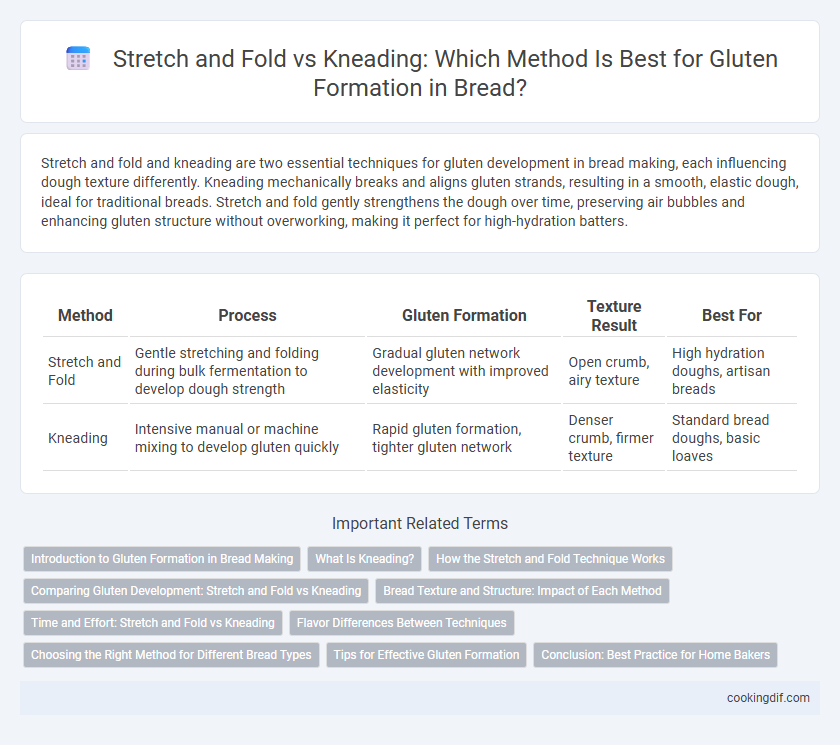Stretch and fold and kneading are two essential techniques for gluten development in bread making, each influencing dough texture differently. Kneading mechanically breaks and aligns gluten strands, resulting in a smooth, elastic dough, ideal for traditional breads. Stretch and fold gently strengthens the dough over time, preserving air bubbles and enhancing gluten structure without overworking, making it perfect for high-hydration batters.
Table of Comparison
| Method | Process | Gluten Formation | Texture Result | Best For |
|---|---|---|---|---|
| Stretch and Fold | Gentle stretching and folding during bulk fermentation to develop dough strength | Gradual gluten network development with improved elasticity | Open crumb, airy texture | High hydration doughs, artisan breads |
| Kneading | Intensive manual or machine mixing to develop gluten quickly | Rapid gluten formation, tighter gluten network | Denser crumb, firmer texture | Standard bread doughs, basic loaves |
Introduction to Gluten Formation in Bread Making
Gluten formation is a critical process in bread making that develops the dough's elasticity and structure through the alignment of glutenin and gliadin proteins in wheat flour. Stretch and fold techniques gently realign these proteins over time, enhancing gluten strength without overworking the dough, while traditional kneading rapidly integrates ingredients and activates gluten bonds through mechanical pressure. Understanding the differences between these methods allows bakers to tailor gluten development for desired bread texture and crumb quality.
What Is Kneading?
Kneading is a physical process in bread making that develops gluten by stretching and aligning the proteins in the dough, creating a strong, elastic network essential for trapping gas during fermentation. This technique involves repeatedly folding and pressing the dough to enhance its texture and improve the bread's rise and crumb structure. Unlike stretch and fold, kneading requires continuous hand or machine manipulation to fully develop the dough's gluten matrix.
How the Stretch and Fold Technique Works
The stretch and fold technique enhances gluten formation by gently elongating and realigning the dough's protein strands, creating a stronger network without overworking it. This method involves periodically stretching the dough outward and folding it over itself, which incorporates air and develops elasticity gradually. Unlike traditional kneading, stretch and fold preserves dough hydration and structure, resulting in improved texture and rise in artisan bread.
Comparing Gluten Development: Stretch and Fold vs Kneading
Stretch and fold techniques enhance gluten development by gently aligning protein strands without overworking the dough, resulting in an open crumb and improved dough strength. Kneading physically agitates the dough, rapidly developing gluten by breaking and reorganizing protein networks, which leads to a denser, more uniform texture. While kneading is effective for quick gluten formation, stretch and fold provide better gas retention and elasticity, crucial for artisan-style bread.
Bread Texture and Structure: Impact of Each Method
Stretch and fold enhances gluten development by gently aligning strands, resulting in an open crumb with a chewy texture ideal for artisan bread. Kneading intensifies gluten formation through continuous pressure, producing a denser, uniform crumb structure suited for sandwich loaves. The choice between stretch and fold or kneading directly influences bread elasticity, crumb openness, and crumb toughness.
Time and Effort: Stretch and Fold vs Kneading
Stretch and fold techniques require less continuous effort and can be done intermittently over 1 to 2 hours, allowing gluten strands to develop gradually with minimal fatigue. Kneading demands more physical exertion concentrated in a shorter time frame, typically 10 to 15 minutes, to rapidly develop gluten structure. Stretch and fold promotes better time efficiency and less strain during long fermentations compared to traditional kneading.
Flavor Differences Between Techniques
Stretch and fold enhances gluten development gently, preserving dough structure and promoting complex flavor through prolonged fermentation and enzymatic activity. Kneading creates a tighter gluten network quickly, producing a denser crumb but with a more straightforward, less nuanced taste. The choice between techniques impacts not only texture but also the depth and subtlety of the bread's flavor profile.
Choosing the Right Method for Different Bread Types
Stretch and fold techniques promote gluten development in high-hydration doughs like ciabatta, enhancing extensibility and gas retention without overworking the dough. Kneading is ideal for firmer doughs such as traditional sandwich bread, providing strong gluten networks necessary for structured crumb and volume. Selecting the right method depends on dough hydration and desired crumb texture, optimizing gluten formation for each specific bread type.
Tips for Effective Gluten Formation
Stretch and fold enhances gluten development by gently aligning the protein strands without overworking the dough, which helps maintain its elasticity and strength. Kneading intensively develops gluten by physically working the dough, but excessive kneading can lead to a dense texture. For optimal gluten formation, use stretch and fold early in fermentation, combine with brief kneading, and allow resting periods to let gluten networks relax and strengthen.
Conclusion: Best Practice for Home Bakers
Stretch and fold technique enhances gluten development gently, preserving dough structure and improving gas retention, ideal for wet, high-hydration doughs. Kneading efficiently aligns gluten strands, providing strength for firmer doughs and quicker preparation times. Home bakers achieve optimal results by combining stretch and fold for initial gluten formation, followed by brief kneading to refine dough texture and elasticity.
Stretch and Fold vs Kneading for gluten formation Infographic

 cookingdif.com
cookingdif.com